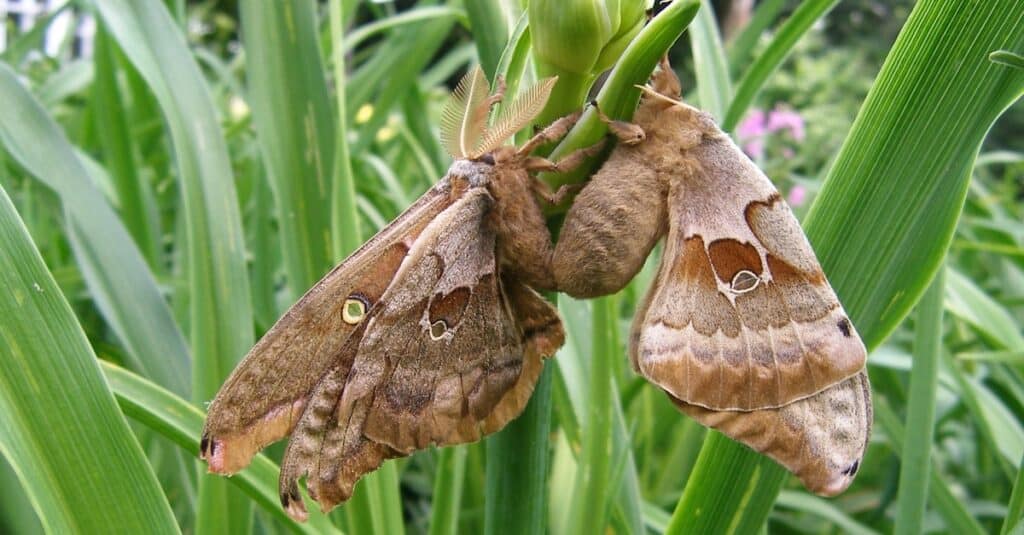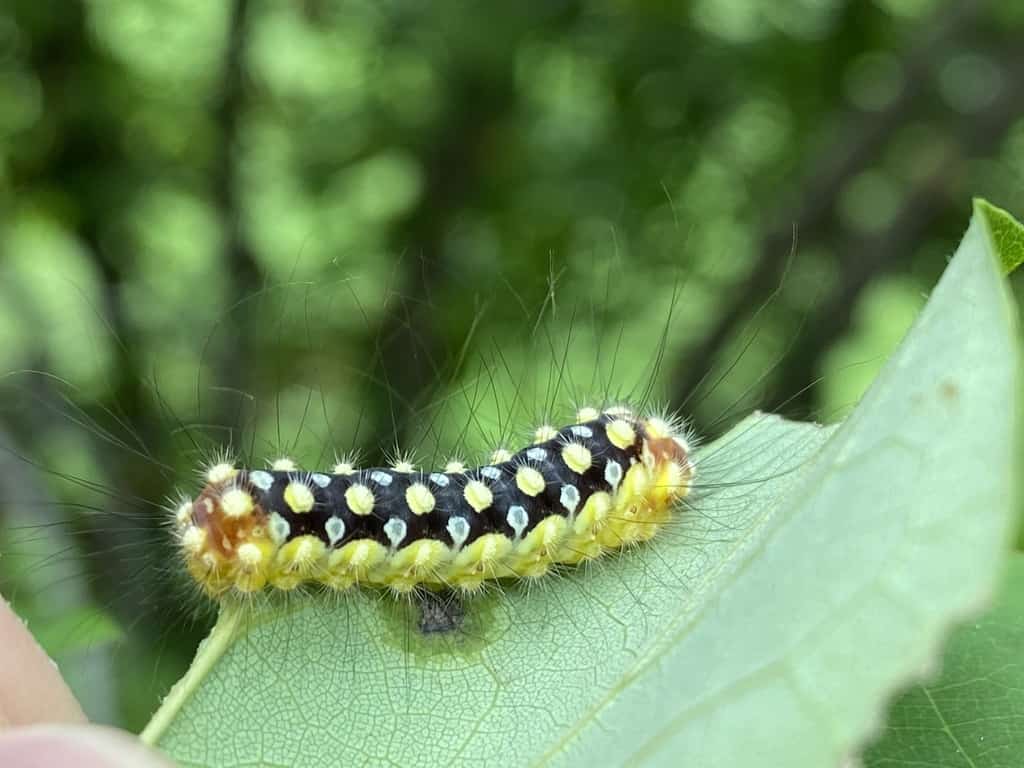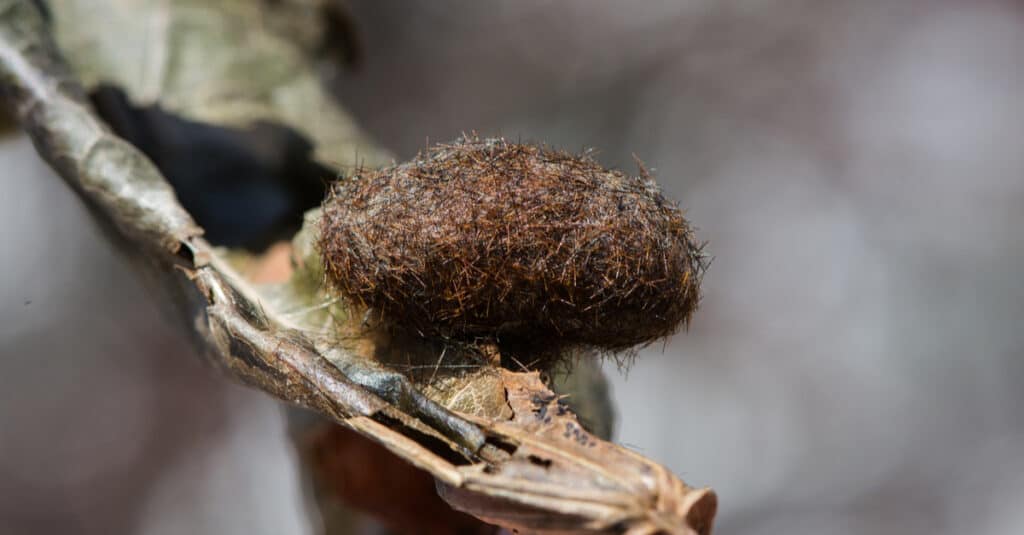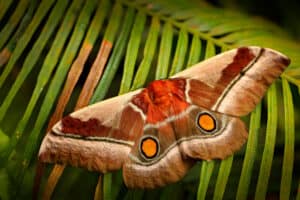Did you know over 150,000 moth species live worldwide, and 14,000 of these live in North America? Moth species range from the tiny 1.2-millimeter-long Mexican Stigmella maya to the vast 11-inch wide Australian Hercules moth. Depending on the species, moths are active at night or during the day. They’re one of our top pollinators and a steady food source for bats, birds, and amphibians, but how do moths reproduce? Let’s discover the strange world of insect reproduction and uncover the complete moth lifecycle from mating to fully grown adult moth.
How Do Moths Find A Mate?

A female moth releases pheromones to attract male moths.
©Matthew Lavigne/Shutterstock.com
Moth mating behavior isn’t fully understood, but scientists believe that female moths release pheromones, that’s a specific chemical scent, into the air. When a male moth flying nearby detects her pheromones with his antennae, he’s able to locate her, and the two then mate.
Most male moths find a mate through the female’s pheromones, but some male types of moths, such as the gold swift moth, also emit pheromones. These unusual moths gather in all-male groups, called leks, to release their pheromones and attract females en masse. On arrival, a female selects a male to mate with.
But pheromones are not the only way moths couple up.
Another type of moth called the corn borer, emits an ultrasonic sound that somehow makes a female moth stay still. Being unable or unwilling to fly away increases the male’s chance of successful mating. Moths utilizing this strategy are called acoustic signaling moths.
How Do Moths Mate Exactly?

During mating, moths’ abdomens join at the tip, but the pair can fly to safety if necessary.
©NuayLub/Shutterstock.com
A physical act must occur once a male and female moth locate each other and choose to mate. This is how moths reproduce.
Moth genitalia are located in their lower abdomen. In order to mate, a male and female join the tips of their abdomens together. The male holds the female still with his “claspers,” which are similar to hands. Then, he passes a spermatophore sac into a space in the female’s abdomen called a bursa copulatrix. This sac contains not only sperm to fertilize the female’s eggs but larvae-supporting nutrients to get newly laid eggs off to a healthy start, too.
If danger, such as a predator or rain, interrupts the mating, then joined moths can fly together to a more secure spot. Experts believe this is why a male moth has claspers. Mating can last for several hours to block other potential suitors from accessing the female, so safety from predators is paramount. Mating moths are particularly vulnerable to predators.
How Moths Reproduce: Moth Lifecycle Explained
Once mating has taken place, a male moth is no longer involved in the reproductive cycle. In fact, soon after mating, many moths die. Some moths, such as Luna moths, don’t even have mouths! These incredible moths emerge from their cocoon and don’t eat or drink; they just look for a mate before dying.
A moth’s lifecycle is described as a complete metamorphosis development lifecycle. This means an incredible series of transformations take place. A moth baby looks and acts nothing like its eventual adult form.
Here’s what happens to a moth after mating:
Moth Eggs

Moth eggs are usually laid beneath a leaf to evade hungry predators.
©Tomasz Klejdysz/Shutterstock.com
Once a female moth has mated, she’ll look for a safe place to lay her fertilized eggs.
The right place depends on the moth’s species. A good area is filled with the moth’s specific food so hatched larvae can eat and grow quickly. For example, sphinx moths require viburnum, blueberry, or snowberry foliage.
Moths are clever creatures that synchronize their egg-laying with the availability of food plants, so spring is the time most moth eggs are laid. In turn, bird species, such as blue tits, synchronize their egg-laying with the availability of caterpillars for their chicks.
Moth eggs are tiny brown, gray, or greenish-white spheres, chiefly laid in precise lines. Most often the mother lays her eggs beneath a leaf to hide them from predators such as birds, insects, and rodents. Luna moths lay up to 400 eggs, which take one to two weeks to hatch into very hungry larvae.
Many female moths die after their precious eggs are laid, so it’s important to find a secure spot.
How Moths Reproduce: Caterpillar Stage

A moth
caterpillar
sheds its skin to fit its rapidly growing body.
©David George / CC BY 4.0 – License
If the eggs remain safe from predators, they hatch into tiny larvae we know as caterpillars. These tiny creatures measure less than a millimeter at hatching, but their voracious appetite is enormous, and growth swiftly occurs.
Moth caterpillars eat leaves, flowers, stems, or roots continuously and grow at an epic rate. Many moth caterpillars double their size in just a few days, and this is why caterpillars change their skin color – they have to grow new, bigger skin! Take the emperor moth, for example. This astonishing moth hatches from an egg and measures just a millimeter or two, but within eight weeks, it reaches 65 millimeters. That’s an epic growth rate and one of the fastest on our planet.
Most caterpillars change their skins four times before cocooning, and each new skin stage is called an instar. New skin grows beneath the top layer, so when their body mass exceeds the skin’s capacity, it splits open to reveal fresh, new skin beneath.
It’s not safe to remain a caterpillar for long because so many predators rely on them for food. Most moth species eat, grow, and pupate within a few weeks, but some moths, like the hawk moth, produce caterpillars that overwinter inside tree trunks or beneath the soil.
Cocoon: Pupating Stage

Inside its cocoon, a caterpillar turns into a fully grown adult moth.
©Landshark1/Shutterstock.com
A fully grown caterpillar still has lots of work to do.
Once it reaches full size, a caterpillar pupates into a pupa; this process is called metamorphosis. Caterpillars do this by forming a cocoon, also called a chrysalis, around its body. This is an essential part of moth reproduction and a wonder of the natural world.
Some moth species spin silk or use their body hair to form a cocoon, while others gather and chew leaves into sticky pulp. Some species create very flimsy cocoons and hide beneath the soil, but others form a rock-hard cocoon that’s so tough scientists think it requires an acidic substance to break free. Whichever method is utilized, the cocoon blends into the local environment so it’s disguised from predators.
Inside its protective cocoon, a caterpillar’s body undergoes a spectacular transformation! It reorganizes itself into a completely different being.
Depending on the species, pupating takes a few days to a year, but when it emerges from its cocoon, a caterpillar is a fully formed adult moth with crumpled wings. Before it can fly, its wings, which are made from keratin, must dry out and harden. This is a very vulnerable time for a newly emerged moth, but it doesn’t take long to get flight-ready.
Moth Reproduction: Adult Moth

When a moth emerges from its cocoon, it must dry and stretch its wings, ready for flight.
©iStock.com/EstuaryPig
Adult moths emerge fully formed from the cocoon. The most noticeable difference is a new pair of wings that allows the moth to expand its range. Also different is its foliage-munching jaws that turn into a delicate straw called a proboscis used to suck up sugary liquids. Moths feed on nectar from plants, which is why it’s important to have night-blooming plants, rotting fruit, or sap in the yard. Some species, such as the luna moth, have no mouth and don’t feed at all. They only live for a few days, surviving on energy stored from their pupation.
In general, moths live from a few weeks to six months. The exact period depends entirely on the moth species. Some long-lived moths hibernate over winter, only emerging during milder weather when food is plentiful.
Adult moths flit through the sky and rest on foliage to hide from predators. The most commonly known moth predators are bats. Bats locate flying moths via echolocation clicks, swooping down on unsuspecting night fliers. However, not all moths are oblivious to this stealthy attack. Tiger moths can hear a bat’s clicks! They drop to the ground or begin to fly in erratic zigzags when they hear hungry bats approaching.
It’s during this adult period that female moths emit pheromones, find a mate, and lay eggs – so the moth reproducing cycle begins all over again.
The photo featured at the top of this post is © SunflowerMomma/Shutterstock.com
Thank you for reading! Have some feedback for us? Contact the AZ Animals editorial team.






